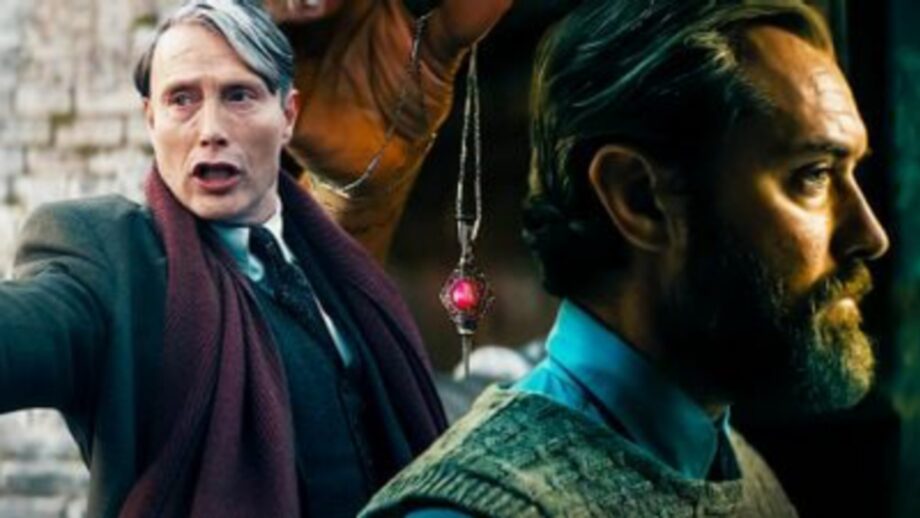The relationship between Albus Dumbledore (Jude Law) and Gellert Grindelwald (Mads Mikkelsen) has already been the subject of speculation, but Fantastic Beasts: The Secrets of Dumbledore has the potential to uncover vital facts in the pair’s background. The third Fantastic Beasts film, directed by David Yates, is The Secrets of Dumbledore. The series continues to tell the stories of famous Harry Potter characters, but this time it takes place decades before the events of J.K. Rowling’s first book series and the subsequent film adaptations.
Fantastic Beasts: The Crimes of Grindelwald reintroduced Albus Dumbledore after focusing on magizoologist Newt Scamander and his encounter with Gellert Grindelwald (previously played by Johnny Depp) during a mission in 1926. Jude Law reprised his role as Professor of Defence Against the Dark Arts at Hogwarts in this prequel. He did, however, have authority within the wizarding community, particularly with Newt, whom he despatched on the expedition to New York City. He also took it upon himself to put an end to Grindelwald’s rebellion. As the film progressed, more information about Dumbledore and Grindelwald’s past became available.
Gellert Grindelwald, who originally featured in the Harry Potter books during tellings of the legendary Headmaster’s past, has become a prominent character in the Fantastic Beasts films. Through book details and Fantastic Beasts, more of Dumbledore and Grindelwald’s past will be revealed. Here’s everything you need to know about Dumbledore and Grindelwald’s relationship ahead of The Secrets of Dumbledore.
Albus Dumbledore first encountered Gellert Grindelwald in 1899, when they were both in their late teens, according to Harry Potter and the Deathly Hallows. Grindelwald ended up in Godric’s Hollow, where he remained with Bathilda Bagshot, his great-aunt. Of course, Dumbledore grew up in Godric’s Hollow and was present when Grindelwald arrived, since he was caring for his family after the death of the Dumbledore matriarch, Kendra.
Despite his Hogwarts diploma, Dumbledore was not in a good mood during the summer of 1899. His first meeting and quick relationship with Grindelwald, on the other hand, was a bright point in an otherwise bleak period. The two appeared to be cut from the same fabric, both being gifted wizards who had yet to be given the opportunity to demonstrate the Wizarding World their full potential. Dumbledore got interested in Grindelwald’s search for the Deathly Hallows as their friendship took a new turn.
Were Dumbledore & Grindelwald In A Romantic Relationship?
Albus Dumbledore is gay and had a romantic relationship with Gellert Grindelwald in canon literature, despite the fact that the Harry Potter novels and the Fantastic Beasts franchise have so far avoided the matter. In 2007, author J.K. Rowling revealed the truth about the Hogwarts Headmaster, but the franchise hasn’t done much to directly depict the LGBTQ+ community in Dumbledore’s prequel arc since then. Despite this, Rowling’s comments proved that the teenagers were lovers during their brief time together in 1899.
The closest Harry Potter has come to confirming Dumbledore and Grindewald’s love relationship was in The Crimes of Grindelwald, when the then-Hogwarts professor said they were “closer than brothers.” The line pointed to the reality of their relationship’s romantic aspects as well as the covenant they made.
Dumbledore & Grindelwald’s Blood Pact & Revolution Plans Explained
The blood contract between Dumbledore and Grindelwald was one of the most intriguing subplots to emerge from The Crimes of Grindelwald. In the Fantastic Beasts series, Credence Barebone was (and still is) in the core of the war between the two wizards. Granted, there was a valid reason for Dumbledore’s inability to track down and defeat Grindelwald: the two had made a blood contract. Grindelwald and Dumbledore made this magically bound contract during the height of their courtship in 1899 when they both promised they would never fight one other. In The Crimes of Grindelwald, Dumbledore saw a flashback through the Mirror of Erised, which saw the formation of the pact. While it has immediate ramifications in terms of the timescale in question, it has become a significant milestone.
With their blood contract in place, the two teenage wizards set about devising their revolution strategy. Grindelwald has his sights set on immortality in order to overturn the International Statute of Wizarding Secrecy, according to the concept of the Master of Death. Grindelwald was able to hide his aim of a new global order by convincing Dumbledore that the revolution would be worth it in the long run by adopting Dumbledore’s slogan of “For the Greater Good.”


